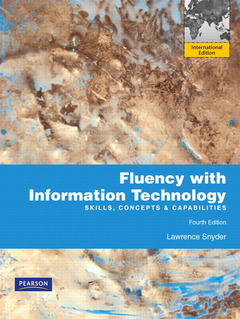Description
Fluency with information technology (4th ed )
Author: SNYDER Lawrence
Language: English
Approximative price 81.69 €
In Print (Delivery period: 12 days).
Add to cart816 p. · 20.3x25.4 cm · Paperback
Description
/li>Contents
/li>
Part 1 Becoming Skilled at Computing
Chapter 1 Defining Information Technology
Terms of Endearment 3
Why Know Just the Right Word 5
Where's the Start Button? 6
Where Is the Computer? 11
How Soft Is Software? 15
The Words for Ideas 17
Analytical Thinking 19
Summary 23
Try It Solutions 24
Review Questions 24
Chapter 2 Exploring the Human Computer Interface
What the Digerati Know 28
Learning about Technology 30
Two Concepts of Computing 35
'Clicking Around' 37
'Blazing Away' 38
Watching Others 39
Principle: Form Follows Function 41
Searching Text Using Find 43
Editing Text Using Substitution 47
Technology: Take It Personally 52
Summary 54
Try It Solutions 54
Review Questions 55
Chapter 3 The Basics of Networking
Making the Connection 58
Comparing Communication Types 60
The Medium of the Message 62
The Internet and the Web 77
The World Wide Web 74
Summary 81
Try It Solutions 81
Review Questions 82
Chapter 4 A Hypertext Markup Language Primer
Marking Up with HTML 85
Marking Up with XHTML 87
Lab Practice I 89
Structuring Documents 92
Lab Practice II 96
Marking Links with Anchor Tags 98
Including Pictures with Image Tags 101
Lists and Tables 106
Cascading Style Sheets (CSS) 111
Style from Files 115
HTML Wrap-Up 118
Summary 119
Try It Solutions 119
Review Questions 120
Chapter 5 Locating Information on the WWW
Searching for Truth 124
Searching in All the Right Places 126
How Is Information Organized? 128
Searching the Web for Information 135
Searching the World Wide Web 141
Web Information: Truth or Fiction? 147
The Burmese Mountain Dog Page 150
Summary 151
Try It Solutions 152
Review Questions 152
Chapter 6 A Case Study in Online Research
Searching for Guinea Pig B 156
Getting Started with Online Research 158
Learning About Fuller 163
Primary Sources 166
Chronfile and 'Everything I Know' 170
Resolving Questions 174
Case Study Wrap-Up 180
Exploring Side Questions 178
Summary 185
Try It Solutions 185
Review Questions 185
interview Vinton G. Cerf 188
Part 2 Algorithms and Digitizing Information
Chapter 7 An Introduction to Debugging
To Err Is Human 195
of Computing 197
Exactly How Accurate Is 'Precise?' 197
Debugging: What's the Problem? 198
A Dialog About Debugging 201
Precision: The High Standards Butterflies and Bugs: A Case Study 204
Debugging Recap 204
No Printer Output: A Classic Scenario 214
Ensuring the Reliability of Software 217
Summary 219
Try It Solutions 220
Review Questions 220
Chapter 8 Representing Information Digitally
Bits and the 'Why' of Bytes 223
Digitizing Discrete Information 225
Fundamental Information Representation 227
Hex Explained 232
Digitizing Text 233
The Oxford English Dictionary 237
Summary 241
Try It Solutions 242
Review Questions 242
Chapter 9 Principles of Computer Operations
Following Instructions 246
Instruction Execution Engines 248
The Fetch/Execute Cycle 250
Anatomy of a Computer 250
The Program Counter: The PC's PC 255
Instruction Interpretation 256
Cycling the Fetch/Execute Cycle 260
Software 262
Integrated Circuits 267
How Semiconductor Technology Works 270
Combining the Ideas 273
Summary 274
Try It Solutions




